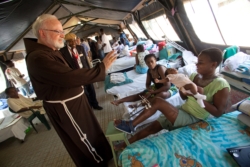From Cardinal Seán’s blog
On Sunday, I returned to Haiti, where I saw the progress of the ongoing earthquake relief efforts.
I went back principally to visit the hospital run by the Order of Malta in the town of Milot. During my first trip I did not have time to get to the hospital there, so I promised them that I would return.
The hospital is called Hopital Sacre Coeur, or Sacred Heart Hospital. I would guess that it is currently the best hospital in Haiti. A committee of the Order of Malta runs it, and the hospital is staffed largely with volunteer doctors and nurses from the U.S., though it is administered by resident Haitian doctors. Also, a community of Irish sisters has recently come down to work in the town there.
We flew to Port-au-Prince and then took a helicopter to Milot. When we arrived we were met by schoolchildren, and they sang for us. A little girl in a wheelchair had a bouquet of flowers for me. It was the first time a cardinal had ever visited there so they wanted to make it special.
The hospital is an amazing institution by the standards of Haiti. It has all kinds of wonderful equipment, much of it donated through the Ascension Health Care System.
Our Catholic hospitals of Boston -- the Caritas Christi system -- has been supporting that hospital. They sent down several very special medical tents.
It cost about $250,000 to put them up. The tents have generators, special flooring, electrical systems and lighting. That allowed for an expansion of the hospital from an 80-bed facility to servicing, at one point, up to 500 patients.
We had 75 doctors and nurses from the Caritas Christi hospitals volunteer to serve in Haiti following the earthquake. We were there with Dr. Mark Pearlmutter, who is head of emergency medicine at Caritas Christi, and Michelle Fey, the head of nursing at Caritas.
It was very encouraging to see how much has been accomplished.
Many children have had limbs amputated. Losing a limb is always a difficult but, for children, it is more complicated because over the period of their growth they will need several new limbs.
There were some babies with tuberculosis of the spine. One little baby was found in the rubble four or five days after the earthquake buried under dead bodies, including those of her parents.
This hospital, because it is out in the countryside, was not at all affected by the earthquake, so it became the major trauma center after the earthquake. The U.S. military and the U.N. would bring several patients a day by helicopter for surgery and medical care at this wonderful hospital.
We returned to Port-au-Prince in the evening and we had dinner at the Nunciature with a number of the officials from the UN, the Banco Interamericano de Desarrollo and other NGOs. The nuncio was good enough to bring these people together so we could hear from them their hopes, objectives and concerns. What an excellent job the nuncio is doing!
The recovery after the earthquake is very, very slow. About 1.5 million people are still in tent cities. You don’t see heavy equipment moving the rubble. There has been a lot of planning going on up until now but you don’t see dramatic improvements.
Right now, the priority is to get permanent housing for the people. That has its challenges, but they’re beginning to initiate projects of bringing in prefabricated housing.
After that, they’ll try to deal with the situation of the schools. Presently, very few children are able to attend school.
Also, the nuncio is anxious to begin to rebuild some of the churches, if nothing else, to be a sign of hope to the people and that things will return to some normalcy. Our bishops’ conference has had conversations with Catholic relief organizations in Europe to try and coordinate what specific projects each will be responsible for. Of course, Catholic relief organizations are still the lead organizations as far as relief efforts. They have done an extraordinary job there.
Please continue to pray for the people of Haiti, and for all who are administering relief efforts.



















